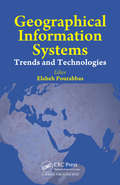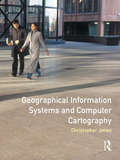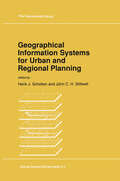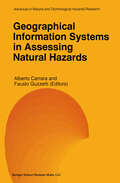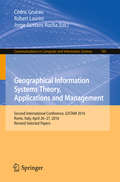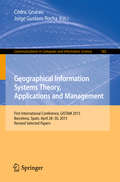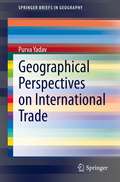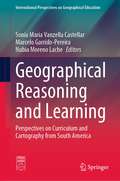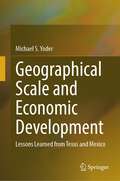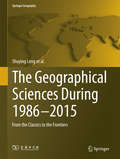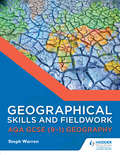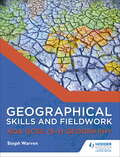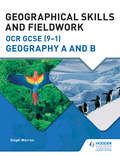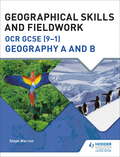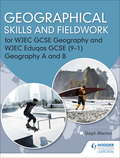- Table View
- List View
Geographical Information and Climatology
by Pierre CarregaThis book includes two parts. The first part is more theoretical and general, and it covers fundamental principles: geospatial climate data measurement; spatial analysis, mapping and climate; geographical information, remote sensing and climatology; and geographical information for initialisation of forecasting and climate models. The second part describes geographical information used in various climate applications of importance today, related to risk: urban climate; air pollution; hydrological problems linked to climatology; forest fires.
Geographical Information and Planning: European Perspectives (Advances in Spatial Science)
by John Stillwell Stan Geertman Stan OpenshawThe 1990s have seen some remarkable changes in geographical information (GI) provision and computer technology that have impacted on many of the activities that constitute planning in all its different forms. However, relatively few texts in the field of geographical information systems (GIS) and planning have been published since Henk Scholten and John Stillwell edited Geographical Information Systems for Urban and Regional Planning in 1990. This volume seeks to redress the balance by showing how GI of various types is being used in urban, physical, environmental, socio-economic and business planning contexts at local, regional and national scales with the assistance of GIS and modelling methods, and how the uses of GI and GI technologies have evolved over the last decade. During this period, a number of meetings took place in Europe in different locations organised initially by European Geographical Information Systems (EGIS, 1990- 94) and more recently by the Joint European Conference and Exhibition (JEC) on Geographical Information (1995-97). These meetings brought together members of the GI community from across the world to discuss GI research and GIS applications. One of the Special Interest Groups associated with the JEC gatherings was that on 'Geographical Information and Planning' and several of the contributions in this book have their origins in papers presented to the group's meetings.
Geographical Information Retrieval in Textual Corpora
by Christian SallaberryThis book addresses the field of geographic information extraction and retrieval from textual documents. Geographic information retrieval is a rapidly emerging subject, a trend fostered by the growing power of the Internet and the emerging possibilities of data dissemination.After positioning his work in this field in Chapter 1, the author makes proposals in the following two chapters. Chapter 2 focuses on spatial and temporal information indexing and retrieval in corpora of textual documents. Propositions for both spatial and temporal information retrieval (IR) are made. Chapter 3 tackles the use of generalized spatial and temporal indexes, which are produced from there in the framework of multi-criteria IR. Geographic IR (GIR) is discussed at length, since this IR combines the criteria of spatial, temporal and thematic research.The author provides a rich bibliographical study of the current approaches focused on the modeling and retrieval of spatial and temporal information in textual documents, and similarity measures developed thus far in the literature.The book concludes with a broad perspective of the remaining scientific challenges. Several areas of research are discussed, such as integration of a domain-based ontology, modeling of spatial footprints from the interpretation of spatial relation, and parsing of relations between features deemed relevant within a document resulting from a GIR process. Contents Foreword, Christophe Claramunt.1. Access by Geographic Content to Textual Corpora: What Orientations ?2. Spatial and Temporal Information Retrieval in Textual Corpora.3. Multicriteria Information Retrieval in Textual Corpora.4. General Conclusion. About the Authors Christian Sallaberry is currently Assistant Professor at the Law, Economics and Management Faculty in Pau, France. His current research interests are in the fields of geographical information retrieval (GIR) in textual corpora: spatial, temporal and thematic information recognition, analyzing, indexing and retrieval. He is interested in spatial, temporal and thematic criteria combinations within a GIR process.
Geographical Information Retrieval in Textual Corpora
by Christian SallaberryThis book addresses the field of geographic information extraction and retrieval from textual documents. Geographic information retrieval is a rapidly emerging subject, a trend fostered by the growing power of the Internet and the emerging possibilities of data dissemination.After positioning his work in this field in Chapter 1, the author makes proposals in the following two chapters. Chapter 2 focuses on spatial and temporal information indexing and retrieval in corpora of textual documents. Propositions for both spatial and temporal information retrieval (IR) are made. Chapter 3 tackles the use of generalized spatial and temporal indexes, which are produced from there in the framework of multi-criteria IR. Geographic IR (GIR) is discussed at length, since this IR combines the criteria of spatial, temporal and thematic research.The author provides a rich bibliographical study of the current approaches focused on the modeling and retrieval of spatial and temporal information in textual documents, and similarity measures developed thus far in the literature.The book concludes with a broad perspective of the remaining scientific challenges. Several areas of research are discussed, such as integration of a domain-based ontology, modeling of spatial footprints from the interpretation of spatial relation, and parsing of relations between features deemed relevant within a document resulting from a GIR process. Contents Foreword, Christophe Claramunt.1. Access by Geographic Content to Textual Corpora: What Orientations ?2. Spatial and Temporal Information Retrieval in Textual Corpora.3. Multicriteria Information Retrieval in Textual Corpora.4. General Conclusion. About the Authors Christian Sallaberry is currently Assistant Professor at the Law, Economics and Management Faculty in Pau, France. His current research interests are in the fields of geographical information retrieval (GIR) in textual corpora: spatial, temporal and thematic information recognition, analyzing, indexing and retrieval. He is interested in spatial, temporal and thematic criteria combinations within a GIR process.
Geographical Information Systems: Trends and Technologies
by Elaheh PourabbasWeb services, cloud computing, location based services, NoSQLdatabases, and Semantic Web offer new ways of accessing, analyzing, and elaborating geo-spatial information in both real-world and virtual spaces. This book explores the how-to of the most promising recurrent technologies and trends in GIS, such as Semantic GIS, Web GIS, Mobile GIS, NoSQL
Geographical Information Systems: A Practical Approach
by Xuan ZhuGeographical information systems (GIS) are powerful tools for reporting on the environment, natural resources and social and economic development; modelling the environmental, biophysical, social and economic processes; assessing environmental and social impacts; evaluating environmental, social and economic policies and actions and dissimilating spatial information. Geographical Information Systems: A Practical Approach provides the fullest available introduction to GIS and their environmental, social and economic applications. This new edition has been substantially revised and updated to incorporate the key developments in GIS technology and spatial data science and their applications that have taken place in recent years.The key features include: A comprehensive coverage of concepts, methods, techniques and tools in GIS for spatial data capturing, processing, visualisation, analysis, modelling and decision-making Incorporation of advanced machine learning techniques for spatial data analysis and modelling Extended coverage of spatial visualisation with 3D mapping and online mapping Weaving together of GIS theory and practice to help readers learn important GIS concepts and methods and develop their understanding through practicals with ArcGIS Pro or QGIS New and updated case studies illustrating the innovative use of GIS for a wide range of applications The second edition of this text continues to bring up-to-date GIS knowledge, tools and practices into one cohesive, comprehensive, concise and self-contained book which is accessible to students, scientists and practitioners in environmental science, earth science, geography, archaeology and other scientific studies that have a spatial dimension.
Geographical Information Systems: A Practical Approach
by Xuan ZhuGeographical information systems (GIS) are powerful tools for reporting on the environment, natural resources and social and economic development; modelling the environmental, biophysical, social and economic processes; assessing environmental and social impacts; evaluating environmental, social and economic policies and actions and dissimilating spatial information. Geographical Information Systems: A Practical Approach provides the fullest available introduction to GIS and their environmental, social and economic applications. This new edition has been substantially revised and updated to incorporate the key developments in GIS technology and spatial data science and their applications that have taken place in recent years.The key features include: A comprehensive coverage of concepts, methods, techniques and tools in GIS for spatial data capturing, processing, visualisation, analysis, modelling and decision-making Incorporation of advanced machine learning techniques for spatial data analysis and modelling Extended coverage of spatial visualisation with 3D mapping and online mapping Weaving together of GIS theory and practice to help readers learn important GIS concepts and methods and develop their understanding through practicals with ArcGIS Pro or QGIS New and updated case studies illustrating the innovative use of GIS for a wide range of applications The second edition of this text continues to bring up-to-date GIS knowledge, tools and practices into one cohesive, comprehensive, concise and self-contained book which is accessible to students, scientists and practitioners in environmental science, earth science, geography, archaeology and other scientific studies that have a spatial dimension.
Geographical Information Systems and Computer Cartography
by Chris B. JonesA concise text presenting the fundamental concepts in Geographical Information Systems (GIS), emphasising an understanding of techniques in management, analysis and graphic display of spatial information.Divided into five parts - the first part reviews the development and application of GIS, followed by a summary of the characteristics and representation of geographical information. It concludes with an overview of the functions provided by typical GIS systems. Part Two introduces co-ordinate systems and map projections, describes methods for digitising map data and gives an overview of remote sensing. Part Three deals with data storage and database management, as well as specialised techniques for accessing spatial data. Spatial modelling and analytical techniques for decision making form the subject of Part Four, while the final part is concerned with graphical representation, emphasising issues of graphics technology, cartographic design and map generalisation.
Geographical Information Systems and Computer Cartography
by Chris B. JonesA concise text presenting the fundamental concepts in Geographical Information Systems (GIS), emphasising an understanding of techniques in management, analysis and graphic display of spatial information.Divided into five parts - the first part reviews the development and application of GIS, followed by a summary of the characteristics and representation of geographical information. It concludes with an overview of the functions provided by typical GIS systems. Part Two introduces co-ordinate systems and map projections, describes methods for digitising map data and gives an overview of remote sensing. Part Three deals with data storage and database management, as well as specialised techniques for accessing spatial data. Spatial modelling and analytical techniques for decision making form the subject of Part Four, while the final part is concerned with graphical representation, emphasising issues of graphics technology, cartographic design and map generalisation.
Geographical Information Systems for Urban and Regional Planning (GeoJournal Library #17)
by Henk J. Scholten and John C. H. StillwellIn August 1989, a Summer Institute was held at the Academie van Bouwkunst, the seventeenth century home of Amsterdam's School of Architecture, Town Planning and Landscape. The meeting brought together experts in Geographical Information Systems from throughout the world to address an international audience of planners. The contents of this book reflect many of the themes that were presented and discussed at the conference. The Summer Institute, let alone this volume, would not have been possible without the support of the International Association for the Development and Management of Existing and New Towns (INTNAIVN), the International Society of City and Regional Planners (ISoCaRP), The National Physical Planning Agency of the Netherlands (RPD) and the Berlage Studio. We wish to acknowledge the assistance provided by these organisations and by the various sponsors: The Ministry of Housing, Physical Planning and Environment, the Municipality of Amsterdam, Logisterion b.v., ESRI, UNISYS, MABON b.v., SPSS, PRIME Computer Inc., PANDATA. The provision of hardware facilities by the various computer companies allowed immensely valuable 'hands on' experience to be gained by all the participants.
Geographical Information Systems in Assessing Natural Hazards (Advances in Natural and Technological Hazards Research #5)
by Alberto Carrara and Fausto GuzzettiThe 16 contributions to Geographical Information Systems in Assessing Natural Hazards report on GIS investigations into landslides, floods, volcanic eruptions, earthquakes and groundwater pollution hazards. Current methods for predicting extreme events are critically discussed, the emphasis being on the intrinsic complexity of this type of operation, requiring many spatial data, long historical records and sound models of the physical processes involved. Within this context, the potentials and limitations of GIS are addressed in terms of data acquisition, spatial data structures and modelling for simulation of the causal phenomena. Geographic Information Systems in Assessing Natural Hazards will help investigators in both public and private institutions to evaluate the actual effectiveness of GIS in coping with natural disasters, and to develop new strategies for projects aimed at the assessment and mitigation of the effects of such catastrophic events.
Geographical Information Systems in Hydrology (Water Science and Technology Library #26)
by Vijay P. Singh and M. FiorentinoThe last few years have witnessed an enormous interest in application of GIS in hydrology and water resources. This is partly evidenced by organization of sev eral national and international symposia or conferences under the sponsorship of various professional organizations. This increased interest is, in a large measure, in response to growing public sensitivity to environmental quality and management. The GIS technology has the ability to capture, store, manipulate, analyze, and visualize the diverse sets of geo-referenced data. On the other hand, hydrology is inherently spatial and distributed hydrologic models have large data requirements. The integration of hydrology and GIS is therefore quite natural. The integration involves three major components: (1) spatial data construction, (2) integration of spatial model layers, and (3) GIS and model interface. GIS can assist in design, calibration, modification and comparison of models. This integration is spreading worldwide and is expected to accelerate in the foreseeable future. Substantial op portunities exist in integration of GIS and hydrology. We believe there are enough challenges in use of GIS for conceptualizing and modeling complex hydrologic processes and for globalization of hydrology. The motivation for this book grew out of the desire to provide under one cover a range of applications of GIS tech nology in hydrology. It is hoped that the book will stimulate others to write more comprehensive texts on this subject of growing importance.
Geographical Information Systems Theory, Applications and Management: Second International Conference, GISTAM 2016, Rome, Italy, April 26-27, 2016, Revised Selected Papers (Communications in Computer and Information Science #741)
by Cédric Grueau Robert Laurini Jorge Gustavo RochaThis book constitutes extended, revised and selected contributions from the Second International Conference on Geographical Information Systems Theory, Applications and Management, GISTAM 2016, held in Rome, Italy, in April 2016. The 10 papers presented in this volume were carefully reviewed and selected from a total of 33 submissions. They contribute to the understanding of relevant trends of current research on the topic, including urban and regional planning; water information systems; geospatial information and technologies; spatio-temporal database management; decision support systems; energy information systems; GPS, and location detection.
Geographical Information Systems Theory, Applications and Management: First International Conference, GISTAM 2015, Barcelona, Spain, April 28-30, 2015, Revised Selected Papers (Communications in Computer and Information Science #582)
by Cédric Grueau Jorge Gustavo RochaThis book constitutes the refereed proceedings of the International Conference on Geographical Information Systems Theory, Applications and Management, held in Barcelona, Spain, in April 2015.The 10 revised full papers presented were carefully reviewed and selected from 45 submissions. The papers address new challenges in geo-spatial data sensing, observation, representation, processing, visualization, sharing and managing. They concern information and communications technology (ICT) as well as management of information and knowledge-based systems.
Geographical Labor Market Imbalances: Recent Explanations and Cures (AIEL Series in Labour Economics)
by Chiara Mussida Francesco PastoreThis book focuses on the questions of how territorial differences in productivity levels and unemployment rates arise in the first place and why territorial differences in labor market performance persist over time. Unemployment divergence and unemployment club convergence have been touched on in a large number of works and have recently also been studied using spatial econometric analysis. In this book we aim to develop the debate to include several important new topics, such as: the reasons why structural changes in some sectors cause slumps in some regions but not in others; the extent to which agglomeration factors explain regional imbalances; the degree of convergence / divergence across EU countries and regions; the role of labor mobility in reducing / increasing regional labor market imbalances; the impact of EU and country-level regional policy in stimulating convergence and the (unsatisfactory) role of active labor market policy in stimulating labor supply in the weakest economic areas.
Geographical Perspectives on International Trade (SpringerBriefs in Geography)
by Purva YadavThis book analyzes spatial and temporal patterns of international trade from a geographical perspective. Trade is an important key to understanding the changing dynamics of economic spaces over time. However, studies by geographers are largely confined to case studies, whereas the spatial dimension is often missing from the approach of economists. This study highlights spatial patterns and commodity composition of global trade and the nature of relationship between trade and other economic attributes. A case study of the MERCOSUR trade block examines inter-regional and intra-regional trade flows. The book captures a comprehensive picture of the structure of international exchange by using ample maps and illustrations as supporting features. Many different methods are applied such as the location quotient to capture concentration and diversification of commodity composition, data reduction techniques such as factor analysis and regression models for relating the economic structures and trade patterns as well as residual mapping among others. This book is a significant contribution to geographical, economical and social sciences research and very useful to graduate and post-graduate students as well as scientists of all related areas who have interest in exploring the changing dynamics of the global economy via trade flows. It provides a road map to further explore different dimensions of international trade and its role in understanding the transforming global economy.
Geographical Reasoning and Learning: Perspectives on Curriculum and Cartography from South America (International Perspectives on Geographical Education)
by Sonia Maria Vanzella Castellar Marcelo Garrido-Pereira Nubia Moreno LacheThis book presents the distinctive theoretical and methodological approaches in geography education in South America and more specifically in Brazil, Chile and Colombia. It highlights cartography and maps as essential tools and provides a meaningful approach to learning in geographical education, thereby giving children and young people the opportunity to better understand their situations, contexts and social conditions. The book describes how South American countries organize their scholar curriculum and the ways in which they deal with geography vocabulary and developing fundamental concepts, methodologies, epistemological comprehension on categories, keywords and themes in geography. It also describes its use in teachers’ practices and learning progressions, the use of spatial representations as a potent mean to visualize and solve questions, and harnesses spatial thinking and geographical reasoning development. The book helps to improve teaching and learning practices in primary and secondary education and as such it provides an interesting read for researchers, students, and teachers of geography and social studies.
Geographical Scale and Economic Development: Lessons Learned from Texas and Mexico
by Michael S. YoderThis book is an attempt to bridge the academic discipline of economic geography with the professional field of economic development. Through case studies of economic development, it illustrates two fundamental concepts of the sub-discipline of economic geography: scale and spatial connections. It demonstrates some of the ways that economic development policies and plans are linked globally, nationally, regionally, and locally. It ties together several studies of communities and transportation systems in Texas and Mexico carried out from the late 2010’s through 2021. The studies shed light on the need to study economic development at multiple scales and to do so through blended qualitative research methods that include conversations with economic development stakeholders, published data, news content from the business and trade media, and direct observation of the built environment.The book is a set of narratives that combine descriptions of the evolution of commercial transportation systems, economic promotion in selected communities, and corresponding changes in the built environment. It is organized into three sections, each of which corresponds to a different scale at which economic development functions: macro, regional, and local.
The Geographical Sciences During 1986—2015: From the Classics To the Frontiers (Springer Geography)
by Shuying Leng Xizhang Gao Tao Pei Guoyou Zhang Liangfu Chen Xi Chen Canfei He Daming He Xiaoyan Li Chunye Lin Hongyan Liu Weidong Liu Yihe Lü Shilong Piao Qiuhong Tang Fulu Tao Lide Tian Xiaohua Tong Cunde Xiao Desheng Xue Linsheng Yang Linwang Yuan Yuanming Zheng Huiyi Zhu Liping ZhuIn four chapters and an introduction, this book systematically helps readers understand the development of the Geographical Sciences both in China and in the world during the past 30 years. Through data analysis of methodologies including CiteSpace, TDA, qualitative analysis, questionnaires, data mining and mathematical statistics, the book explains the evolution of research topics and their driving factors in the Geographical Sciences and its four branches, namely Physical Geography, Human Geography, Geographical Information Science and Environmental Geography. It also identifies the role of the Geographical Sciences in the analysis of strategic issues such as global change and terrestrial ecosystems, terrestrial water cycle and water resources, land change, global cryosphere evolution and land surface processes on the Tibetan Plateau, economic globalization and local responses, regional sustainable development, remote sensing modelling and parameter inversion, spatial analysis and simulation, and tempo-spatial processes and modelling of environmental pollutants. It then discusses research development and inadequacy of Chinese Geographical Sciences in the above-mentioned topics, as well as in the fields including Geomorphology and Quaternary environmental change, Ecohydrology, ecosystem services, the urbanization process and mechanism, medical and health geography, international rivers and transboundary environment and resources, detection and attribution of changes in land surface sensitive components, and uncertainty of spatial information and spatial analysis. It shows that the NSFC has driven the development in all these topics and fields. In addition, the book summarises trends of the Geographical Sciences in China and the research level in major countries of the world through an overview of geographical education in colleges and universities, the analysis of publications, citations and author networks of SCI/SSCI and CSCD indexed articles, and the description of Sino-USA, Sino-UK and Sino-German cooperation. This book serves as an important reference to anyone interested in geographical sciences and related fields.
Geographical Skills and Fieldwork for AQA GCSE (9–1) Geography
by Steph WarrenMaximise every student's grade potential with a step-by-step approach to learning, improving and applying the geographical and fieldwork skills they need to achieve stand-out success under the reformed AQA GCSE Geography specification.- Provides a complete, tailor-made solution to teaching the cartographic, graphical, numerical and statistical skills emphasised in the 2016 AQA GCSE geography specification- Helps you prepare students for the changed fieldwork assessments and new question formats with a dedicated section on geographical enquiries- Supports students of varying abilities by moving from clear explanations of each skill to easy-to-follow guidance on applying the skills in an examination context- Offers plenty of opportunities to put newly-acquired skills into practice through a range of activities for all learners, as well as extension tasks designed for students targeting the top grades- Boosts students' confidence tackling terminal assessment with skills-focused exam-style questions and insider tips on common question types and topics- Cuts down your marking time and enables students to monitor their own progress by including answers for every activity and exam-style question
Geographical Skills and Fieldwork for AQA GCSE (9–1) Geography
by Steph WarrenMaximise every student's grade potential with a step-by-step approach to learning, improving and applying the geographical and fieldwork skills they need to achieve stand-out success under the reformed AQA GCSE Geography specification.- Provides a complete, tailor-made solution to teaching the cartographic, graphical, numerical and statistical skills emphasised in the 2016 AQA GCSE geography specification- Helps you prepare students for the changed fieldwork assessments and new question formats with a dedicated section on geographical enquiries- Supports students of varying abilities by moving from clear explanations of each skill to easy-to-follow guidance on applying the skills in an examination context- Offers plenty of opportunities to put newly-acquired skills into practice through a range of activities for all learners, as well as extension tasks designed for students targeting the top grades- Boosts students' confidence tackling terminal assessment with skills-focused exam-style questions and insider tips on common question types and topics- Cuts down your marking time and enables students to monitor their own progress by including answers for every activity and exam-style question
Geographical Skills and Fieldwork for AQA GCSE (9–1) Geography (PDF)
by Steph WarrenMaximise every student's grade potential with a step-by-step approach to learning, improving and applying the geographical and fieldwork skills they need to achieve stand-out success under the reformed AQA GCSE Geography specification. - Provides a complete, tailor-made solution to teaching the cartographic, graphical, numerical and statistical skills emphasised in the 2016 AQA GCSE geography specification - Helps you prepare students for the changed fieldwork assessments and new question formats with a dedicated section on geographical enquiries - Supports students of varying abilities by moving from clear explanations of each skill to easy-to-follow guidance on applying the skills in an examination context - Offers plenty of opportunities to put newly-acquired skills into practice through a range of activities for all learners, as well as extension tasks designed for students targeting the top grades - Boosts students' confidence tackling terminal assessment with skills-focused exam-style questions and insider tips on common question types and topics - Cuts down your marking time and enables students to monitor their own progress by including answers for every activity and exam-style question 9781471865916
Geographical Skills and Fieldwork for OCR GCSE (9–1) Geography A and B
by Steph WarrenMaximise every student's grade potential with a step-by-step approach to learning, improving and applying the geographical and fieldwork skills they need to achieve stand-out success under the reformed OCR A and B GCSE Geography specifications.- Provides a complete, tailor-made solution to teaching the cartographic, graphical, numerical and statistical skills emphasised in the 2016 OCR A and B GCSE Geography specifications- Helps you prepare students for the changed fieldwork assessments and new question formats with a dedicated section on geographical enquiries- Supports students of varying abilities by moving from clear explanations of each skill to easy-to-follow guidance on applying the skills in an examination context- Offers plenty of opportunities to put newly-acquired skills into practice through a range of activities for all learners, as well as extension tasks designed for students targeting the top grades- Boosts students' confidence tackling terminal assessment with skills-focused exam-style questions and insider tips on common question types and topics- Cuts down your marking time and enables students to monitor their own progress by including answers for every activity and exam-style question
Geographical Skills and Fieldwork for OCR GCSE (9–1) Geography A and B
by Steph WarrenMaximise every student's grade potential with a step-by-step approach to learning, improving and applying the geographical and fieldwork skills they need to achieve stand-out success under the reformed OCR A and B GCSE Geography specifications.- Provides a complete, tailor-made solution to teaching the cartographic, graphical, numerical and statistical skills emphasised in the 2016 OCR A and B GCSE Geography specifications- Helps you prepare students for the changed fieldwork assessments and new question formats with a dedicated section on geographical enquiries- Supports students of varying abilities by moving from clear explanations of each skill to easy-to-follow guidance on applying the skills in an examination context- Offers plenty of opportunities to put newly-acquired skills into practice through a range of activities for all learners, as well as extension tasks designed for students targeting the top grades- Boosts students' confidence tackling terminal assessment with skills-focused exam-style questions and insider tips on common question types and topics- Cuts down your marking time and enables students to monitor their own progress by including answers for every activity and exam-style question
Geographical Skills and Fieldwork for WJEC GCSE Geography and WJEC Eduqas GCSE (9–1) Geography A and B
by Steph WarrenExam Board: WJECLevel: GCSESubject: GeographyFirst Teaching: September 2016First Exam: June 2018Maximise every student's performance with a step-by-step approach to learning, improving and applying the geographical and fieldwork skills they need to achieve their best under the reformed WJEC/Eduqas GCSE Geography specifications.- Provides a complete, tailor-made solution to teaching the cartographic, graphical, numerical and statistical skills emphasised in the 2016 WJEC Eduqas A and B GCSE Geography specifications- Helps you prepare students for the changed fieldwork assessments and new question formats with a dedicated section on geographical enquiries- Supports students of varying abilities by moving from clear explanations of each skill to easy-to-follow guidance on applying the skills in an examination context- Offers plenty of opportunities to put newly-acquired skills into practice through a range of activities for all learners, as well as extension tasks designed for students targeting the top grades- Boosts students' confidence tackling terminal assessment with skills-focused exam-style questions and insider tips on common question types and topics- Cuts down your marking time and enables students to monitor their own progress by including answers for every activity and exam-style question



